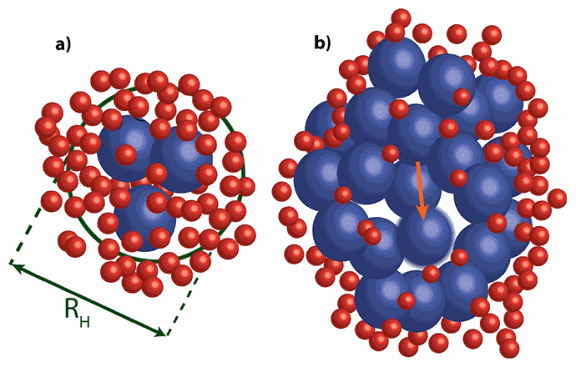It is very difficult to overestimate the importance of colloidal suspensions. Besides being an integral part of our everyday life (food, cosmetics, drugs), they also serve as an excellent model system for basic science.
Studies of monomodal (a single, well-defined size distribution) colloidal suspensions have helped us to understand a wide range of phenomena, such as glass transitions, relaxation in amorphous media, and hydrodynamic interactions at the nanoscale to name a few. A well-established knowledge of monomodal suspensions has provided the impetus to shift our attention toward more complex mixtures of particles with two distinct size distributions, bimodal suspensions. From skimmed milk to volcanic ashes, nature provides us with numerous examples of bimodal systems.
Gaining insight into the mechanism governing the structure and the dynamics of bimodal mixtures would be valuable for fundamental understanding as well as for industrial applications. Utilizing the bright, coherent x-ray photons at X-ray Science Division beamline 8-ID at the U.S. Department of Energy's Advanced Photon Source at Argonne National Laboratory, scientists have gained a clearer picture of the relationship between the composition and the equilibrium dynamics in highly asymmetric bimodal colloidal suspensions.
It has been theoretically predicted and experimentally verified that a large mismatch in the particle dimensions in bimodal suspensions may result in an attractive force between the large constituents, referred to as the “depletion interaction.” The strength of such an interaction is determined mainly by the ratio of the particle sizes, their relative concentration, and the volume fraction of the colloidal particles. As a consequence, the structure of bimodal mixtures is a complex function of its composition.
A significant amount of theoretical and experimental work has been devoted to understanding the link between the composition and structure in bimodal systems. Along with the structure, the dynamics of the suspended particles is expected to be very sensitive to the composition. To date, there is very little understanding of the equilibrium dynamics of bimodal mixtures.
Studies devoted to dynamic relaxation in colloidal gels have shown that adding even a very small amount of small particles to a large sphere matrix strongly affects its temporal and spatial dynamical heterogeneity. To what extent the equilibrium dynamics in ergodic suspensions are affected by the substitution of the host particle matrix with particles of very different dimensions is still an open question.
Using x-ray photon correlation spectroscopy, a well-established tool to study nanoscale dynamics, the researchers studied a series of hard-sphere bimodal suspensions with a size ratio of 5. Analysis of the time evolution of the interference pattern, called “speckles,” formed by the coherent superposition of the x-ray photons scattered from the probed sample, yielded insight onto the dynamics at nanometer length scales matching the interparticle separation distances. By systematically changing the relative content of the large and the small spheres, the researchers were able to tune the strength of the attractive interaction between the large particles to reveal the sensitivity of the dynamics in bimodal suspensions to subtle variations in this parameter.
A physical picture based on a complete de-mixing of the constituent spheres into monomodal domains was proposed to explain the presence of multiple dynamic time scales. According to this picture, the mobility of the particles within such domains is governed by the strength of the osmotic pressure exerted by the small spheres on the large sphere domains.
The proposed model successfully links the observed distribution of dynamical time scales to the structural spatial heterogeneity.
Changes in the relative content of both species were found to affect the dynamics in the large and small sphere domains in different ways. Interestingly, the diffusion of the small spheres was found to be independent of the composition. On the contrary, as the content of the large spheres increases, the dynamical time scales of the large spheres spans more than a decade in time, reflecting the transition from a co-operative motion of the entire aggregate to the diffusion of a single particle within the large domains.
See: M. Sikorski, A. R. Sandy, and S. Narayanan, “Depletion-Induced Structure and Dynamics in Bimodal Colloidal Suspensions”, Phys. Rev. Lett. 106, 183301 (2011).
DOI: 10.1103/PhysRevLett.106.188301
Author affiliations: Argonne National Laboratory
Correspondence: [email protected]
This work and the use of the APS supported by the U.S. DOE Office of Science under Contract No. DE-AC02-06CH11357.
The Advanced Photon Source at Argonne National Laboratory is one of five national synchrotron radiation light sources supported by the U.S. Department of Energy’s Office of Science. The APS is the source of the Western Hemisphere’s brightest high-energy x-ray beams for research in virtually every scientific discipline. More than 3,500 scientists representing universities, industry, and academic institutions from every U.S. state and several foreign nations visit the APS each year to carry out applied and basic research in support of the BES mission to understand, predict, and ultimately control matter and energy at the electronic, atomic, and molecular levels in order to provide the foundations for new energy technologies and to support DOE missions in energy, environment, and national security.
Argonne National Laboratory seeks solutions to pressing national problems in science and technology. The nation's first national laboratory, Argonne conducts leading-edge basic and applied scientific research in virtually every scientific discipline. Argonne researchers work closely with researchers from hundreds of companies, universities, and federal, state and municipal agencies to help them solve their specific problems, advance America's scientific leadership and prepare the nation for a better future. With employees from more than 60 nations, Argonne is managed by UChicago Argonne, LLC for the U.S. Department of Energy's Office of Science.

